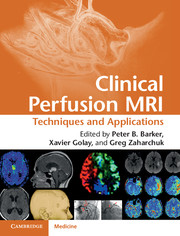Book contents
- Frontmatter
- Contents
- List of Contributors
- Foreword
- Preface
- List of Abbreviations
- Section 1 Techniques
- Section 2 Clinical applications
- 8 MR perfusion imaging in neurovascular disease
- 9 MR perfusion imaging in neurodegenerative disease
- 10 MR perfusion imaging in clinical neuroradiology
- 11 MR perfusion imaging in oncology: neuro applications
- 12 MR perfusion imaging in oncology: applications outside the brain
- 13 MR perfusion imaging in breast cancer
- 14 MR perfusion imaging in the body: kidney, liver, and lung
- 15 MR perfusion imaging in cardiac diseases
- 16 MR perfusion imaging in pediatrics
- Index
- References
12 - MR perfusion imaging in oncology: applications outside the brain
from Section 2 - Clinical applications
Published online by Cambridge University Press: 05 May 2013
- Frontmatter
- Contents
- List of Contributors
- Foreword
- Preface
- List of Abbreviations
- Section 1 Techniques
- Section 2 Clinical applications
- 8 MR perfusion imaging in neurovascular disease
- 9 MR perfusion imaging in neurodegenerative disease
- 10 MR perfusion imaging in clinical neuroradiology
- 11 MR perfusion imaging in oncology: neuro applications
- 12 MR perfusion imaging in oncology: applications outside the brain
- 13 MR perfusion imaging in breast cancer
- 14 MR perfusion imaging in the body: kidney, liver, and lung
- 15 MR perfusion imaging in cardiac diseases
- 16 MR perfusion imaging in pediatrics
- Index
- References
Summary
Introduction
The MRI-based methods for measuring perfusion and related vascular characteristics that are described in this book have multiple research and clinical applications in oncology. The oncological applications specific to the brain are detailed in Chapter 11. This current chapter provides an overview of oncology applications outside the brain, covering both current clinical practice and research techniques. The technical aspects of image acquisition and analysis are only alluded to briefly, except where these details form a critical component of understanding the study data and their interpretation.
Various perfusion MRI techniques are performed in oncology imaging. Outside the brain, the majority of applications are based on T1-weighted dynamic contrast-enhanced (DCE)-MRI, although dynamic susceptibility contrast (DSC) and arterial spin labeling (ASL) are now used increasingly often in research studies. In this section, all ‘MR perfusion imaging’ refers to T1-weighted DCE-based techniques unless explicitly stated otherwise. It is important to appreciate that T1-weighted DCE-MRI is an umbrella term that covers many similar acquisition and analysis approaches, which may have important differences in their practical application and for comparison between studies.
- Type
- Chapter
- Information
- Clinical Perfusion MRITechniques and Applications, pp. 238 - 254Publisher: Cambridge University PressPrint publication year: 2013

